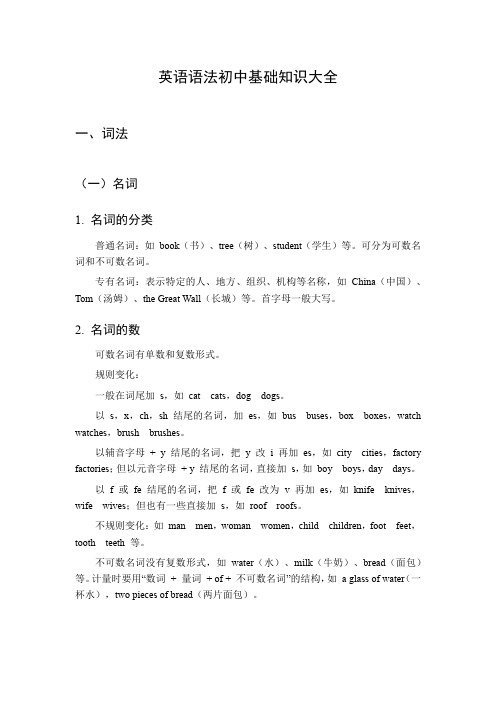初高中英语语法大全(基础)
- 格式:doc
- 大小:343.50 KB
- 文档页数:86


英语语法初中基础知识大全一、词法(一)名词1. 名词的分类普通名词:如book(书)、tree(树)、student(学生)等。
可分为可数名词和不可数名词。
专有名词:表示特定的人、地方、组织、机构等名称,如China(中国)、Tom(汤姆)、the Great Wall(长城)等。
首字母一般大写。
2. 名词的数可数名词有单数和复数形式。
规则变化:一般在词尾加s,如cat cats,dog dogs。
以s,x,ch,sh 结尾的名词,加es,如bus buses,box boxes,watch watches,brush brushes。
以辅音字母+ y 结尾的名词,把y 改i 再加es,如city cities,factory factories;但以元音字母+ y 结尾的名词,直接加s,如boy boys,day days。
以 f 或fe 结尾的名词,把 f 或fe 改为v 再加es,如knife knives,wife wives;但也有一些直接加s,如roof roofs。
不规则变化:如man men,woman women,child children,foot feet,tooth teeth 等。
不可数名词没有复数形式,如water(水)、milk(牛奶)、bread(面包)等。
计量时要用“数词+ 量词+ of + 不可数名词”的结构,如 a glass of water(一杯水),two pieces of bread(两片面包)。
3. 名词的所有格’s 所有格:一般在名词后加’s,如Mary’s book(玛丽的书)。
以s 结尾的复数名词,直接加’,如the students’ desks(学生们的课桌)。
表示两人或多人共有某物时,只在最后一个名词后加’s;若分别拥有,则每个名词后都加’s,如Tom and Jim’s room(汤姆和吉姆共有的房间);Tom’s and Jim’s rooms(汤姆的房间和吉姆的房间)。

高中英语语法基础知识总结大全1高中英语语法大全一、主语从句1.定义:用作主语的从句叫做主语从句。
2.构成:关联词+简单句3.引导主语从句的关联词有三类:(1)从属连词that。
如:Thattheywereintruthsisterswasclearfromthefacialresembla ncebetweenthem.很明显,她们确是亲姐妹,她们的脸型很相似。
(2)从属连词whether。
如:Whetherhe’llcomehereisn’tclear.他是否会来这里还不清楚。
(3)连接代词who,whom,whose,what,which,whoever,whatever,whichever连接副词where,when,how,why。
如:Whatshedidisnotyetknown.她干了什么尚不清楚。
Howthishappenedisnotcleartoanyone.这事如何发生的,谁也不清楚。
Whoevercomesiswelcome.不论谁来都欢迎。
Whereveryouareismyhome____myonlyhome.你所在的任何地方就是我的家____我唯一的家。
二、宾语从句1.定义:用作宾语的从句叫宾语从句。
2.构成:关联词+简单句3.引导宾语从句的关联词有三类:(1)从属连词that。
如:Hetoldusthathefeltill.他对我们说他感到不舒服。
Iknowhehasreturned.我知道他已经回来了。
注:that在引导宾语从句时也并不是任何情况下都可以省略。
在以下情况下,that不能省略。
1.EverybodycouldseewhathappenedandthatTomwasfrightened. (and连接两个宾语从句,that宾语从句放在and的后面时,that 不能省略。
)大家都会看出所发生的事情并知道Tom非常害怕。
2.Iknownothingabouthimexceptthatheisfromthesouth.(that 引导的宾语从句作介词宾语时,that不能省略。

高中英语语法总结大全作为一门语言学科,英语的语法在学习英语中占据了非常重要的地位。
下面将对高中英语语法进行总结,以帮助学生们更好地学习英语。
一、英语基础语法1.名词:名词是指人、物、地点、抽象概念等的名称。
名词可以分为可数名词和不可数名词。
2.代词:代词用来代替名词,以避免重复。
代词分为人称代词、指示代词、疑问代词、不定代词和相互代词等。
3.形容词:形容词用来描述名词或代词的特征和品质,如颜色、大小、形状等。
4.副词:副词用来描述动词、形容词、其他副词或整个句子的性质或方式。
5.动词:动词是指行为、状态或存在的词语。
动词可以分为及物动词和不及物动词。
6.介词:介词用来表示名词或代词与其他词语之间的关系,如时间、空间、方式等。
7.连词:连词用来连接句子、短语或单词。
连词包括并列连词、从属连词和关联词。
8.数词:数词用来表示数量,可以分为基数词和序数词。
二、句子的结构和类型9.主语和谓语:主语是句子的核心,谓语是描述主语动作、状态或属于的词语。
10.宾语:宾语是由动词直接影响的名词或代词。
11.间接宾语:间接宾语通常用于表达接受或给予的对象。
12.句子类型:简单句、复合句和复合句。
简单句包括主语和谓语,复合句包括主句和从句,复杂句则由两个或更多的从句组成。
三、时态和语态13.时态:英语共有12种时态,包括现在时、过去时、将来时等。
每个时态都有其相应的情境和实际用途。
14.语态:英语有两种语态,分别为被动语态和主动语态。
被动语态用来描述动作是如何被执行的,而主动语态则强调动作的执行者。
四、非谓语动词15.动词不定式:动词不定式由“to + 动词原形”组成。
它可以作为动词、名词或形容词的形式使用。
16.分词:分词是现在分词或过去分词形式的动词。
现在分词通常以ing结尾,过去分词通常以ed或en结尾。
17.动名词:动名词是动词与ing形式结合而成的名词。
它用作主语、宾语、补语和介词短语的组成成分。
五、语法结构和用法18.从句:从属连词引导的句子称为从句。

高中英语语法基础知识大全
1、从句
(1)定义:定义从句是一个以句子成分完整的句子,并且在另一个句子里起到
连接或者补充另外一句话的作用。
它是一种句子里的成分,只是可以当作完整的句子立足。
(2)类型:
A.宾语从句
B.状语从句
C.表语从句
D.主语从句
其中,宾语从句最常见;状语从句和主语从句比较少见;表语从句最少见。
2、句子分类
(1)简单句
定义:一句话最基本的语言单位,句中只存在一个主语和谓语,句尾通常不存在连接词,其他部分可以加上定语、状语等。
例句:
He laughed.
她笑了。
(2)并列句
定义:并列句由two or more independent clauses组成,即由不加任何连接词或连接副词相连接的有主语谓语的句子。
例句:
He is happy and she is sad.
他高兴,她难过。
(3)复合句
定义:一个复合句包含两个或两个以上的简单句,并以连接词相连接,形成更大的句子结构。
例句:
He laughed,but she didn't. 他笑了,但她没有笑。

英语语法基础知识大全一、词性分类1. 名词(Noun):表示人、事、物、地点、时间等概念的词,如:person, book, city, time等。
2. 动词(Verb):表示动作、状态、存在等概念的词,如:run, be, have等。
3. 形容词(Adjective):修饰名词或代词,表示人或事物的特征、性质或状态的词,如:big, happy, beautiful等。
4. 副词(Adverb):修饰动词、形容词、其他副词或整个句子的词,表示时间、地点、程度、方式等概念的词,如:quickly, very, here等。
5. 冠词(Article):放在名词前面,起修饰和限定作用的词,如:a, an, the等。
6. 代词(Pronoun):代替名词的词,如:I, you, he, she, it, they等。
7. 数词(Numeral):表示数量或顺序的词,如:one, two, first, second等。
8. 介词(Preposition):表示名词、代词与其他词之间关系的词,如:in, on, at, 等。
9. 连词(Conjunction):连接词、短语、从句或句子的词,如:and, but, or, because等。
10. 感叹词(Interjection):表示情感或感叹的词,如:oh, wow, alas等。
二、句子成分1. 主语(Subject):执行动作或处于某种状态的名词或代词,如:She is a teacher.2. 谓语(Predicate):说明主语的动作、状态或特征的动词或动词短语,如:She teaches English.3. 宾语(Object):动作的承受者或状态的对象,如:She teaches English.4. 表语(Complement):对主语或宾语进行补充说明的词或短语,如:She is a teacher.5. 定语(Attributive):修饰名词或代词的形容词、名词、代词等,如:a beautiful girl.6. 状语(Adverbial):修饰动词、形容词、副词或整个句子的词或短语,如:She teaches English well.三、基本句型1. 主语 + 谓语(S + V):表示主语的动作或状态,如:She sings.2. 主语 + 谓语 + 宾语(S + V + O):表示主语的动作和动作的承受者,如:She teaches English.3. 主语 + 系动词 + 表语(S + LinkV + C):表示主语的状态或特征,如:She is a teacher.4. 主语 + 谓语 + 间接宾语 + 直接宾语(S + V + IndirectO + DirectO):表示主语的动作、动作的间接承受者和直接承受者,如:She gives me a book.5. 主语 + 谓语 + 宾语 + 宾语补足语(S + V + O + C):表示主语的动作、动作的承受者和承受者的状态或特征,如:She calls me a fool.。
一、词法1、名词(1)名词的可数与不可数可数名词指表示的人或事物可以用数来计量,它有单数与复数两种形式。
不可数名词指所表示的事物不能用数来计量。
物质名词与抽象名词一般无法用数目来统计,都称为不可数名词。
不可数名词前一般不能用冠词a、an来表示数量,没有复数形式。
要表示“一个……”这一概念,就须加a piece of这一类短语。
要注意许多名词在汉语里看来是可数名词,在英语里却不可数。
如:chalk,paper,bread,rice,grass,news等。
(2)名词复数的规则变化A.一般情况下加-s。
B.以s,x,ch,sh,结尾的加-es。
C.以辅音字母加y结尾的改y为i再加-es。
D.以f,fe结尾的,去掉f或fe,变成v再加-es。
(3)名词的所有格A.单数名词词尾加’s,复数名词词尾若没有s,也要加’s。
如:the worker’s bike,the Children’s ballB.表示几个人共有一样东西,只需在最后一个人的名字后加’s若表示各自所有,则需在各个名字后加’s。
如:This is Lucy and Lily’s room.These are Kate’s and jack’s rooms.C.如果是通过在词尾加-s构成的复数形式的名词,只加’。
如:the students’books,the girls’blouses(另外:如果名词是有生命的,我们就用’s结构来表示所有关系。
如果名词所表示的事物是无生命的,我们就要用名词+of+名词的结构来表示所有关系。
)2、代词人称代词,物主代词,反身代词,指示代词,不定代词(1)人称代词第一人称单数I me my mine myself复数we us our ours ourselves第二人称单数you you your yours yourself复数you you your yours yourselves第三人称单数he him his his himselfshe her her hers herselfit it its its itself复数they them their theirs themselves(2)物主代词物主代词的用法:形容词性物主代词后面一定要跟一个名词;名词性物主代词可作主语、表语、宾语。
动词时态,被动语态一、一般现在时1.一般现在时表示经常发生、习惯性动作、客观真理、科学事实、格言,目前的特征、状态、能力等。
2.主句是一般将来时,时间、条件状语从句中用一般现在时表示将来。
如:I’ll go there after I finish my work./ If it rains tomorrow, I won’t go there. 3.在以here, there开头的句子里,go, come等少数动词的一般在时表示正在发生的动作。
例如:There goes the bell.铃响了。
There comes the bus.汽车来了。
Here she comes.她来了。
二、现在进行时1.表示正在进行的动作。
2.表示按计划安排即将发生的动作。
例如:She is leaving for Beijing.她要去北京。
He is working as a teacher tomorrow.从明天起他要做老师。
My father is coming to see me this Saturday.这个星期六我爸爸要来看我。
3.代替一般现在时,描绘更加生动。
例如:The Changjiang River is flowing into the east.江水滚滚向东流。
The sun is rising in the east.太阳从东方冉冉升起。
4.大多数动词可用于进行时,但也有些动词不用于进行时。
常见的有:exist, live, understand, mean, owe, belong to, know, doubt, suppose, remember, forget, believe,trust,want,wish,refuse,like,hate,dislike,prefer,mind,hope等。
三、现在完成时1.表示过去发生的动作对现在产生的影响或结果,或说话时已完成的动作。
初高中英语语法基础知识大全《初高中英语语法基础知识大全》一、语法分类1. 词法:(1)单词类:名词、代词、形容词、副词、数词、动词、介词、连词等。
(2)句子类:定语从句、状语从句、名词性从句、主谓宾、并列句等。
2. 名词(1)可数名词:表示可以分开计数的人或事物,如:book(书)、pen(钢笔)、desk(桌子)等。
(2)不可数名词:表示无法分开计数的人或事物,如:water (水)、tea(茶)、music(音乐)等。
3. 形容词(1)比较等级:表示两种或两种以上的比较程度,如:taller (更高的)、stronger(更强壮的)、better(更好的)等。
(2)最高级:表示三种或三种以上的比较程度,如:tallest (最高的)、strongest(最强壮的)、best(最好的)等。
4. 动词(1)一般现在时:表示经常性或习惯性的动作,如:do、go、study、read等。
(2)一般过去时:表示过去曾经发生过的动作,如:did、went、studied、read等。
(3)现在分词:表示与主语同时发生的动作,如:running(跑)、studying(学习)、working(工作)等。
(4)过去分词:表示过去曾经发生过的动作,如:run(跑)、studied(学习)、worked(工作)等。
5. 介词(1)位置介词:表示在某一位置的方位,如:in(在……里)、on(在……上)、at(在……旁)等。
(2)时间介词:表示与时间有关的词,如:in(在……时候)、from(从……开始)、before(在……之前)等。
二、语法使用1. 冠词(1)定冠词:用在名词前,表示特指某一个人或物,如:the book (这本书)、the pen(这支钢笔)等。
(2)不定冠词:用在名词前,表示一般概念,如:a book(一本书)、an apple(一个苹果)等。
2. 助动词(1)be动词:表示状态、特征、身份等,如:am(我是)、is (是)、are(们是)等。
矿产资源开发利用方案编写内容要求及审查大纲
矿产资源开发利用方案编写内容要求及《矿产资源开发利用方案》审查大纲一、概述
㈠矿区位置、隶属关系和企业性质。
如为改扩建矿山, 应说明矿山现状、
特点及存在的主要问题。
㈡编制依据
(1简述项目前期工作进展情况及与有关方面对项目的意向性协议情况。
(2 列出开发利用方案编制所依据的主要基础性资料的名称。
如经储量管理部门认定的矿区地质勘探报告、选矿试验报告、加工利用试验报告、工程地质初评资料、矿区水文资料和供水资料等。
对改、扩建矿山应有生产实际资料, 如矿山总平面现状图、矿床开拓系统图、采场现状图和主要采选设备清单等。
二、矿产品需求现状和预测
㈠该矿产在国内需求情况和市场供应情况
1、矿产品现状及加工利用趋向。
2、国内近、远期的需求量及主要销向预测。
㈡产品价格分析
1、国内矿产品价格现状。
2、矿产品价格稳定性及变化趋势。
三、矿产资源概况
㈠矿区总体概况
1、矿区总体规划情况。
2、矿区矿产资源概况。
3、该设计与矿区总体开发的关系。
㈡该设计项目的资源概况
1、矿床地质及构造特征。
2、矿床开采技术条件及水文地质条件。